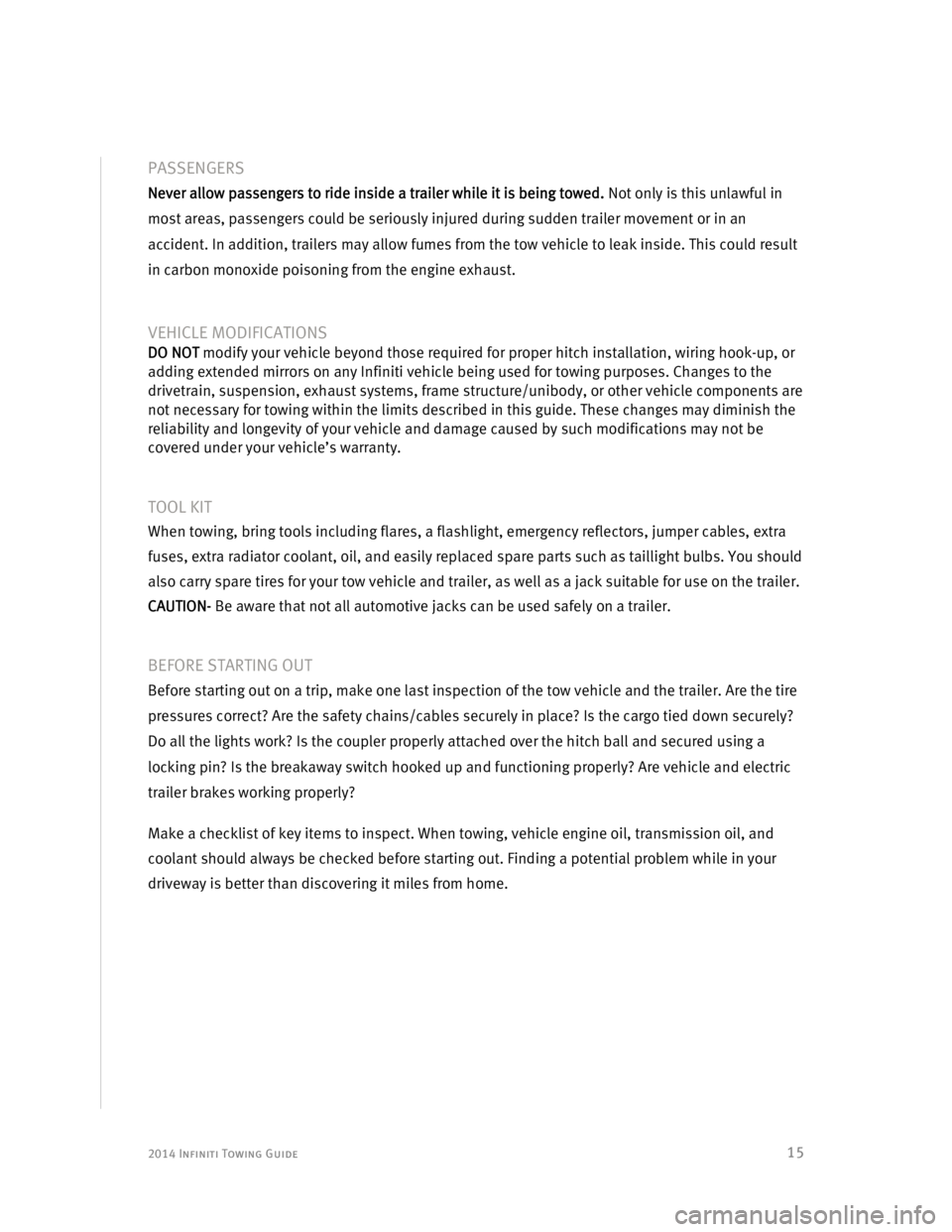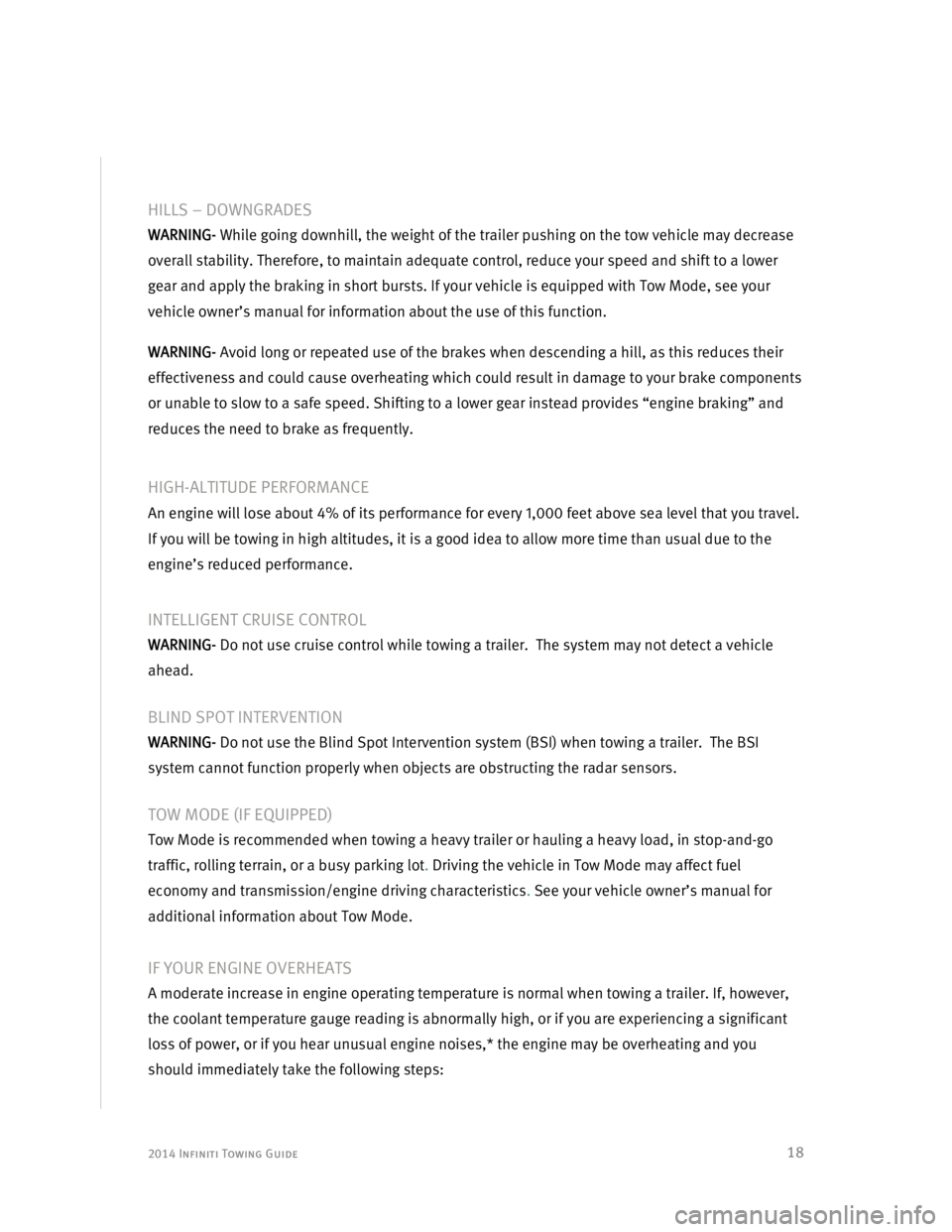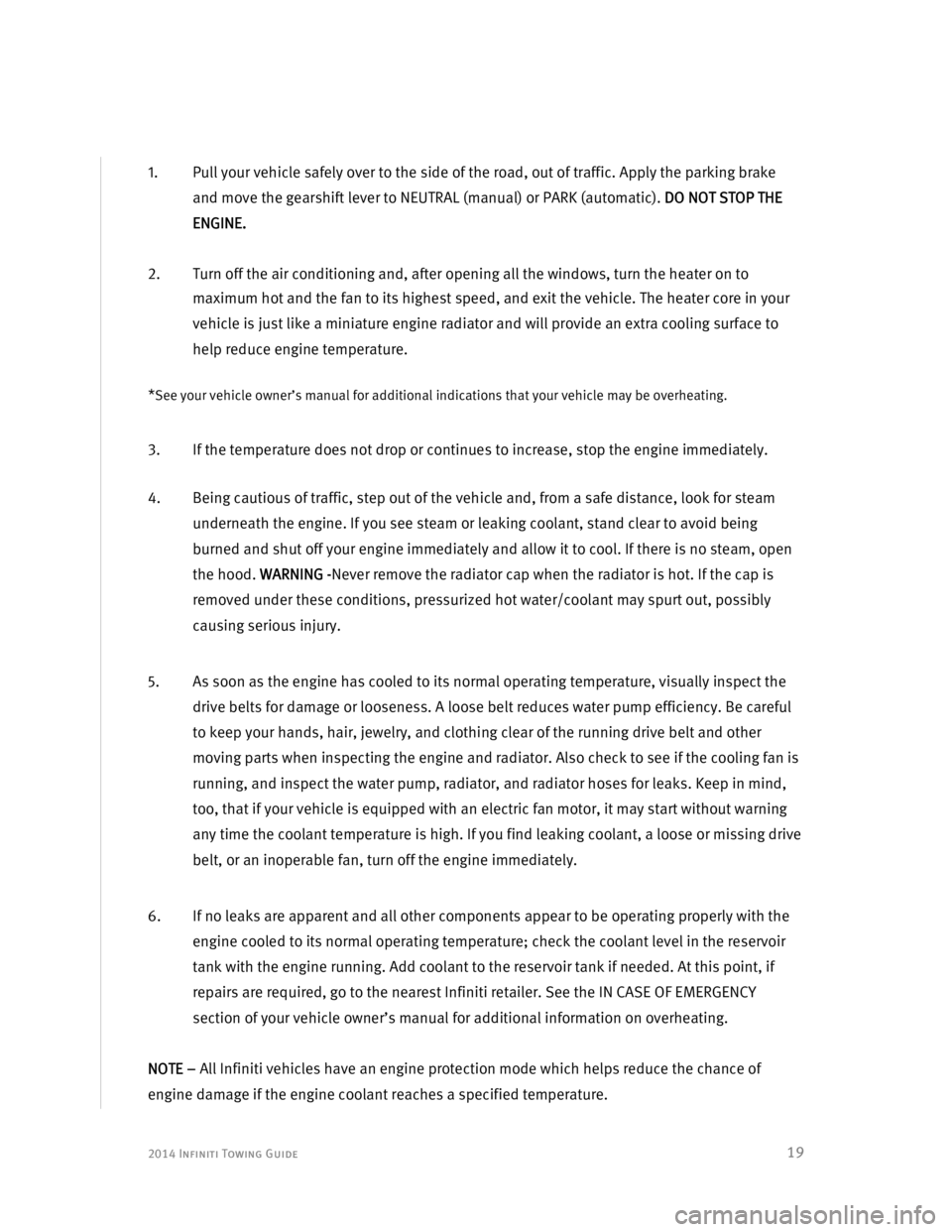coolant INFINITI QX80 2014 Towing Guide
[x] Cancel search | Manufacturer: INFINITI, Model Year: 2014, Model line: QX80, Model: INFINITI QX80 2014Pages: 25, PDF Size: 0.88 MB
Page 16 of 25

2014 Infiniti Towing Guide
15
PASSENGERS
Never allow passengers to ride inside a trailer while it is being towed. Not only is this unlawful in
most areas, passengers could be seriously injured during sudden trailer movement or in an
accident. In addition, trailers may allow fumes from the tow vehicle to leak inside. This could result
in carbon monoxide poisoning from the engine exhaust.
VEHICLE MODIFICATIONS
DO NOT modify your vehicle beyond those required for proper hitch installation, wiring hook-up, or
adding extended mirrors on any Infiniti vehicle being used for towing purposes. Changes to the
drivetrain, suspension, exhaust systems, frame structure/unibody, or other vehicle components are
not necessary for towing within the limits described in this guide. These changes may diminish the
reliability and longevity of your vehicle and damage caused by such modifications may not be
covered under your vehicle’s warranty.
TOOL KIT
When towing, bring tools including flares, a flashlight, emergency reflectors, jumper cables, extra
fuses, extra radiator coolant, oil, and easily replaced spare parts such as taillight bulbs. You should
also carry spare tires for your tow vehicle and trailer, as well as a jack suitable for use on the trailer.
CAUTION- Be aware that not all automotive jacks can be used safely on a trailer.
BEFORE STARTING OUT
Before starting out on a trip, make one last inspection of the tow vehicle and the trailer. Are the tire
pressures correct? Are the safety chains/cables securely in place? Is the cargo tied down securely?
Do all the lights work? Is the coupler properly attached over the hitch ball and secured using a
locking pin? Is the breakaway switch hooked up and functioning properly? Are vehicle and electric
trailer brakes working properly?
Make a checklist of key items to inspect. When towing, vehicle engine oil, transmission oil, and
coolant should always be checked before starting out. Finding a potential problem while in your
driveway is better than discovering it miles from home.
Page 18 of 25

2014 Infiniti Towing Guide
17
Of course, backing up should be done only at very slow speeds. For large trailers that obstruct your
rearward vision, have someone outside the vehicle act as a “spotter” to guide you along.
WARNING- Do not use the Back-up Collision Intervention system (BCI) when towing a trailer. The
BCI system cannot function properly when objects are obstructing the radar sensor beams.
PARK SMART
A tow vehicle and trailer can be an unwieldy combination in a small area, so always try to park
where you will have a relatively easy time maneuvering. Once parked, always block the wheels on
both the tow vehicle and the trailer.
CAUTION- Parking on a slope is not recommended. If, however, you must park on a slope and your
vehicle is equipped with an automatic transmission, there are some precautions you should take:
�Š Turn the wheels of the tow vehicle towards the side of the road away from the center of the road,
and apply the parking brake and only then move the gear lever into PARK.
�Š Next, have someone block the wheels once the tow vehicle and trailer are in position and are
being held by the vehicle’s brake.
CAUTION-If you move the lever into PARK before blocking the wheels and applying the parking
brake, it may be difficult to later shift out of PARK. Transmission damage may also occur.
PASS CAREFULLY
As mentioned in the introduction to this section, because of the added weight of the trailer,
acceleration capability is reduced and you will require a longer distance to pass another vehicle. Be
certain you have sufficient time and space to pass safely.
WARNING- Never attempt to pass on hills or when going around curves. Because the trailer does
not follow the exact path as the tow vehicle on turns, safely passing and cornering while towing
takes considerably more distance and turning space than normal. More weight means more time to
speed up and your tow vehicle may not have enough power on a mountain grade for safe passing.
HILLS – UPGRADES
If your vehicle is equipped with an automatic transmission, it is designed to select automatically
the correct gear for the best towing comfort and performance as the incline increases. To maintain
speed or avoid up and down shifts, manually shift to a lower gear as needed.
The added weight of a trailer places an increased load on the engine and cooling system, so
monitor your coolant temperature gauge and automatic transmission fluid temperature gauge (if
equipped) carefully. At the first sign of overheating, pull to the side of the road. See IF YOUR ENGINE
OVERHEATS later in this section for more information.
Page 19 of 25

2014 Infiniti Towing Guide
18
HILLS – DOWNGRADES
WARNING- While going downhill, the weight of the trailer pushing on the tow vehicle may decrease
overall stability. Therefore, to maintain adequate control, reduce your speed and shift to a lower
gear and apply the braking in short bursts. If your vehicle is equipped with Tow Mode, see your
vehicle owner’s manual for information about the use of this function.
WARNING- Avoid long or repeated use of the brakes when descending a hill, as this reduces their
effectiveness and could cause overheating which could result in damage to your brake components
or unable to slow to a safe speed. Shifting to a lower gear instead provides “engine braking” and
reduces the need to brake as frequently.
HIGH-ALTITUDE PERFORMANCE
An engine will lose about 4% of its performance for every 1,000 feet above sea level that you travel.
If you will be towing in high altitudes, it is a good idea to allow more time than usual due to the
engine’s reduced performance.
INTELLIGENT CRUISE CONTROL
WARNING- Do not use cruise control while towing a trailer. The system may not detect a vehicle
ahead.
BLIND SPOT INTERVENTION
WARNING- Do not use the Blind Spot Intervention system (BSI) when towing a trailer. The BSI
system cannot function properly when objects are obstructing the radar sensors.
TOW MODE (IF EQUIPPED)
Tow Mode is recommended when towing a heavy trailer or hauling a heavy load, in stop-and-go
traffic, rolling terrain, or a busy parking lot. Driving the vehicle in Tow Mode may affect fuel
economy and transmission/engine driving characteristics. See your vehicle owner’s manual for
additional information about Tow Mode.
IF YOUR ENGINE OVERHEATS
A moderate increase in engine operating temperature is normal when towing a trailer. If, however,
the coolant temperature gauge reading is abnormally high, or if you are experiencing a significant
loss of power, or if you hear unusual engine noises,* the engine may be overheating and you
should immediately take the following steps:
Page 20 of 25

2014 Infiniti Towing Guide
19
1. Pull your vehicle safely over to the side of the road, out of traffic. Apply the parking brake
and move the gearshift lever to NEUTRAL (manual) or PARK (automatic). DO NOT STOP THE
ENGINE.
2. Turn off the air conditioning and, after opening all the windows, turn the heater on to
maximum hot and the fan to its highest speed, and exit the vehicle. The heater core in your
vehicle is just like a miniature engine radiator and will provide an extra cooling surface to
help reduce engine temperature.
*
See your vehicle owner’s manual for additional indications that your vehicle may be overheating.
3. If the temperature does not drop or continues to increase, stop the engine immediately.
4. Being cautious of traffic, step out of the vehicle and, from a safe distance, look for steam
underneath the engine. If you see steam or leaking coolant, stand clear to avoid being
burned and shut off your engine immediately and allow it to cool. If there is no steam, open
the hood. WARNING -Never remove the radiator cap when the radiator is hot. If the cap is
removed under these conditions, pressurized hot water/coolant may spurt out, possibly
causing serious injury.
5. As soon as the engine has cooled to its normal operating temperature, visually inspect the
drive belts for damage or looseness. A loose belt reduces water pump efficiency. Be careful
to keep your hands, hair, jewelry, and clothing clear of the running drive belt and other
moving parts when inspecting the engine and radiator. Also check to see if the cooling fan is
running, and inspect the water pump, radiator, and radiator hoses for leaks. Keep in mind,
too, that if your vehicle is equipped with an electric fan motor, it may start without warning
any time the coolant temperature is high. If you find leaking coolant, a loose or missing drive
belt, or an inoperable fan, turn off the engine immediately.
6. If no leaks are apparent and all other components appear to be operating properly with the
engine cooled to its normal operating temperature; check the coolant level in the reservoir
tank with the engine running. Add coolant to the reservoir tank if needed. At this point, if
repairs are required, go to the nearest Infiniti retailer. See the IN CASE OF EMERGENCY
section of your vehicle owner’s manual for additional information on overheating.
NOTE – All Infiniti vehicles have an engine protection mode which helps reduce the chance of
engine damage if the engine coolant reaches a specified temperature.